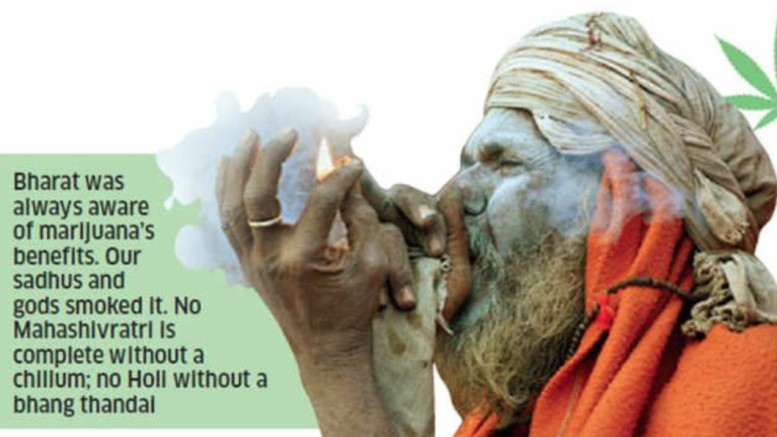 •Taking both marijuana and alcohol during early pregnancy may disrupt foetal development.
•Taking both marijuana and alcohol during early pregnancy may disrupt foetal development.
•The benefits of marijuana are many. It’s a sleep aid, appetite enhancer, anxiety and pain reliever. It has brought immense relief to the terminally ill. It’s also a muscle relaxant, aiding and speeding recovery from bodybreaking fevers like chikungunya.
MUMBAI, 10 NOVEMBER, 2019 (GPN): New preclinical research has shown in animal models that exposure to cannabinoids (CBs), which includes cannabidiol (CBD) and tetrahydrocannabinol (THC), during early pregnancy can cause malformations in the developing embryo. The research also demonstrated that co-exposure to CBs and alcohol increased the likelihood of birth defects involving the face and brain. The study, funded by the National Institute on Alcohol Abuse and Alcoholism (NIAAA), part of the National Institutes of Health, was published in Scientific Reports. The compounds are present in Marinjuana and in India the ayurvedic formulations containing marijuana are Jatiphaladi Churna and Madanananda Modaka.
Its therapeutic uses in Indian Ayurveda are for
1. Agnimandya (in which food is not properly digested due to the diminished power of Jaṭharāgni )
2. Atisara (Acute diarrhea )
3. Grahaniroga ( Irritable bowel syndrome)
4. Klaibya ( erectile dysfunction)
5. Anidrd (Insomnia)
As of August 2018, thirty-one US states, the District of Columbia, Puerto Rico, and Guam authorize medical use of cannabis.
An additional 15 states have limited programs that authorize use of high cannabidiol/low delta-9-tetrahydrocannabinol (THC) cannabis formulations for treatment of childhood epilepsy, especially refractory seizures.
A cannabis extract with equal proportions of THC and cannabidiol is approved for medical use in 27 countries (including Canada), but not in the United States, for treatment of pain and muscle spasticity due to multiple sclerosis.
Smoked and inhaled cannabis have a rapid onset of effect (typically minutes) and relatively short duration of action (typically two to four hours).
Oral cannabis has a slow onset of effect (typically half to one hour) and long duration of action (typically 4 to 12 hours). This may lead to inadvertent overdosing; when patients don’t experience effects as soon as they expect, they may take another dose, resulting in a cumulative overdose.
Drug interactions –THC is a substrate for the CYP2C9 and CYP3A4 drug-metabolizing enzymes, so may interact pharmacokinetically with other substances metabolized by these enzymes, such as tricyclic antidepressants, protease inhibitors, or sildenafil
THC potentiates the sedative effects of other central nervous system depressants such as alcohol and benzodiazepines.
Based on known adverse effects of recreational cannabis use, it seems prudent to avoid recommending medical cannabis to individuals with a history of schizophrenia, a recent acute myocardial infarction or episode of cardiac tachyarrhythmia, or who must drive or operate heavy machinery. ENDS
There are two elements found in marijuana plants: THC and CBD. The THC stands for tetrahydrocannabinol, which will give you a high unlike CBD element that relieves pain. Coca-Cola is more interested in the CBD part of it, which eases inflammation and reduces pain. The aim is not to intoxicate. Heineken via Lagunitas (as also Corona) is dabbling in both. Its beverage Hi-Fi Hops comes in two versions: one with 10 mg THC and the other with 5 mg of THC and 5 mg of CBD.There is also a third element in addition to CBD and THC — cannabis sativa seed oil or hempseed oil. According to Quartz, it has many “health-promoting compounds”, and, like CBD, is nonintoxicating.Looks like it’s not just the beverage companies that have an interest in cannabis. The trend now extends to the beauty industry. The skincare brand Origins has launched a cannabinoid face mask, in collaboration with Sephora.
Both the major strains of the marijuana plant — sativa and indica — are native to India. During the monsoon, the plant grows wild in gardens and campuses.
In 1985, under pressure from the US (which had launched the war on drugs with much fanfare), Rajiv Gandhi clamped the draconian NDPS — the Narcotic Drugs and Psychotropic Substances Act. This put traditional bhang and ganja on the same level as smack, brown sugar etc.
“Cannabis (hemp)” means: (a) charas, that is, the separated resin, in whatever form, whether crude or purified, obtained from the cannabis plant and also includes concentrated preparation and resin known as hashish oil or liquid hashish;(b) ganja, that is, the flowering or fruiting tops of the cannabis plant (excluding the seeds and leaves when not accompanied by the tops), by whatever name they may be known or designated; and(c) any mixture, with or without any neutral material, of any of the above forms of cannabis or any drink prepared therefrom.As always in India, once a ban is put in place, it stays in place. There is no rolling back, even as the countries originally responsible for these bans evolve, revoke and move forward. (The war on drugs, meanwhile, after squandering billions of dollars and taking hundreds of thousands of lives, is widely considered a failure.)This happened with Section 377 and homosexuality. England had moved on, while we clung to it. The same goes for the ban on marijuana. As America (and the world) adapts to changing times and steams ahead with innovations in the cannabis industry, the Indian ostrich still has its head stuck in American sand.
This April, the Uttarakhand government belatedly gave permission to cultivate nonnarcotic hemp — a plan mooted first in 1985, then shelved. This allows India to participate partially in a global $1 trillion industry, of which Europe, America and China have long been a part of. But all we can do is make fibre. The seeds and flowers remain illegal; so does hempseed oil.


Be the first to comment on "In India marijuana is legal as an Ayurveda drug: Dr KK Aggarwal"